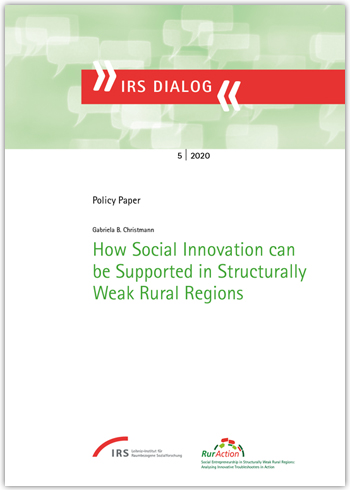Main Content
How Social Innovation can be Supported in Structurally Weak Rural Regions
IRS Dialog 5 | 2020

A downward spiral has been set in motion in many structurally weak rural regions of Europe in the past decades. While the precise economic and social conditions of individual regions in Europe often diverge significantly (Hennebry 2018; Chatzichristos/Nagopoulos 2020; Willett/Lang 2018), the same pattern nevertheless tends to appear: Compared with cities, the conditions of everyday life in structurally weak rural regions is – due to its limited economic productivity, career perspectives, and a worsening provision of infrastructure (such as utilities) – rather unfavourable. This has led to ever more rural inhabitants leaving the countryside. Young, well-educated individuals in particular have turned their backs on rural regions. A consequence is a deficit in the required labour force and skilled workers, leading to a further deterioration in the economic prospects of such areas (Müller/Siedentop 2003; Manthorpe/Livsey 2009; Weber 2012). This often makes it difficult to break the downward spiral and reverse its effects.
Although many rural inhabitants appreciate countryside living and see its advantages in comparison to the city (such as the proximity to nature, better living conditions, often a private house and garden, and more calm), they nevertheless complain of the dismantling of infrastructure. The disappearance of shops, the local bakery, doctor’s surgery, village pub, or post office – and thus of places of communication – is perceived as a severe transformation in everyday life. The reduction of opportunities to communicate with one another in rural regions and villages, compared to earlier times, is also lamented (Christmann 2019).
In the face of such challenges, actors in some parts of the countryside have become active and are taking things into their own hands in order to improve their situation (Christmann 2017, 2019). Several have even founded small companies, creating workplaces and an economic basis for themselves and others. In many instances it is the case that actors leave behind more well-trodden paths and develop novel approaches in the search for solutions. In some cases, actors have found support among fellow campaigners who have set themselves the goal of promoting innovative problem-solving approaches and, once tried and tested, of professionally supporting creative processes and grass-roots initiatives, as well as business start-ups. The talk is of social entrepreneurs. Even if there is no single definition for this concept, due to the existence of very different types of social enterprise, social entrepreneurs can be characterised as visionary actors with a pronounced orientation towards action, who develop and implement, or otherwise support, social-innovation approaches by entrepreneurial means and know-how (Christmann 2011; Pestoff/Hulgård 2015).
In fact, throughout Europe there is an abundance of innovative initiatives to be seen in the countryside (Olmedo/van Twuijver/O’Shaughnessy 2019), advanced by rural inhabitants, social entrepreneurs, or both in collaboration, and which is here termed “social innovation”. To social innovation one can ascribe the potential for meeting the diverse challenges of our society. For some time, political decision makers have also placed hope in social innovation. Early on, the European Commission set itself the target of promoting the empowerment of people and the development of social innovation (Bureau of European Policy Advisers 2010; see also Jenson/Harrison 2013, Christmann 2020). There are, however, still many questions about the conditions in which social innovation emerges in rural areas, how its potential can be developed, and what support strategies can be used to assist it.
The basis of this Policy Paper is empirical research that tackles these questions. By analysing innovative initiatives in the countryside, the conditions and the actor constellations necessary for their emergence has been reconstructed. The phases through which the processes of innovation are carried out have also been investigated, and critical junctures that could pose a threat to their further progress have been identified, as well as favourable factors. Using the example of failed initiatives, it has been possible to explore what conditions could be adverse, or what obstacles are insurmountable, for an innovative initiative.
The focus was placed, firstly, on innovative initiatives that had been developed independently by rural inhabitants in various actor constellations. Secondly, the project investigated the ways in which social enterprises developed novel solutions together with rural inhabitants. It proved to be the case that social enterprises, too, require supporting factors for their work, despite their experience and professionalism.
The following will initially consider what can be understood by rural social innovation. The various phases of the innovation process will then be determined. Alongside these phases, the central findings of our research on significant factors for innovative work will be summarised. In connection with this, inferences will be drawn from our findings and recommendations for action will be derived concerning the political management and support of social innovation in rural regions. Four political levels will be considered: the municipal/regional level, the state level (for federal systems), the national level, and the level of the European Union.
It should be mentioned that a prefinal version of this Policy Paper was discussed in detail in the context of policy roundtables held between June and September 2020 in the form of webinars. There, key aspects of the paper were considered in the light of specific framework conditions in Germany, Portugal, Greece, Austria and Ireland. Furthermore, a policy roundtable was organised with a focus on the European Union level. The results of these policy roundtables are reported in the annex to this policy paper.

